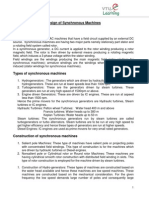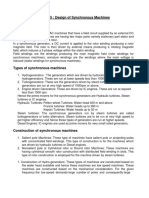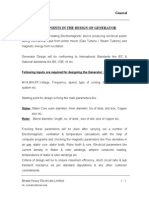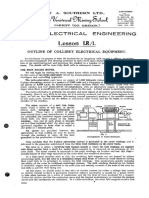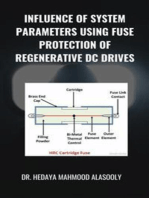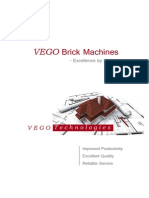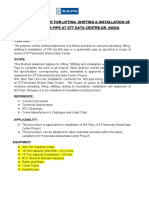Project Bhel 2
Uploaded by
jatt_yankyProject Bhel 2
Uploaded by
jatt_yankyTURBO GENERATORS INTRODUCTION TO TURBO GENERATORS :
The growing use of electrical in the world leads to new problems concerning the generation of electrical energy. The most frequently used machines, for the generation of electrical power are the synchronous machines. Faraday's law of electromagnetic induction states that the induced voltage is proportional to the rate of change of the linkage of the magnetic lines of force.In the case of electrical rotating machinery the part of the machine,in which the voltage is induced is called the armature.The component part of the electrical machine which carries the excited or field winding for the production of the required magnetic lines of force is called the field system.If the field is so provided that the of force after a particular distance change their direction,the field system is said to posses alternating poles.Alternating poles mean that the poles are alternatively north and south poles.The change of flux is caused when the armature moves in a flux set by alternating poles.It is naturally just the same whether the poles moves and the armature winding remains stationary or the poles remains stationary and the armature moves.Almost all alternating current generators are now a days designed with rotating field system.This arrangement is the natural order of things for a few very good reasons:
1. The high voltage,high current and therefore high-power handling element is the armature on any AC or DC rotating electrical machine.Armature coils are therefore larger than field coils. 2. Since no alternate switching of coil polarities is needed on an AC machine, no commutator function is needed.Thus,the high power windings may be made stationary for direct connection.The universal motor is an exception to this condition. 3. The field structure and coils are not ordinarily required to handle more than a fraction of the total power.Thus,their rotating electrical connection may be made smaller.Since no polarity switching is required,collector are usually used.
4. The armature and field coils are both placed in slots in the punched magnetic structure,but the stationary armature can be conveniently made to with deeper to handle the required larger coils. 5. It is easier to cool the stator than the rotor which is an advantage of the normal AC construction. 6. The main reason for designing the alternating generator with rotating field system is that AC generators are designed for high voltages(433kV),which are difficult to be tapped from slip rings incase of rotating armature type.For smaller voltages the rotating armature type may be cheaper but in order to achieve uniformity all AC generators are designed with rotating fields. 7. It is economical to have armature winding on the stator and field winding on the rotor.In order to illustrate this,consider a 3-phase ,starconnected,200MVA,11kV,synchronous machine.Its line current is 10,500 A.If the armature winding is placed on the rotor,three slip rings each capable of handling10,500 A would be required.Further each slip ring must be properly insulated from the shaft for a voltage of 11/1.732,i.e.6.35 kV.The star-point of the 3 phase winding must also be brought out through fourth slip-ring,in order to connect it to a grounded metal plate through a resistance. Assume now that low-power required for the field winding is 1 MW at 500 volts.Then the excitng or field current is 1000/0.5=2000A.Only two slip rings,each capable of handling 2000A,are required.Also each slip ring should be insulated from the shaft for a voltage of 500 volts only.This shows that it is cheaper to have field winding on the rotor rather than the armature winding.Thus the construction of synchronous machine with armature winding on the rotor is much more economical.In addition,a synchronous machine with armature winding on the stator and field winding on the rotor has reduced slip ring losses and is therefore more efficient. 8. Stationary armature windings can be insulated satisfactorily for higher voltages,allowing the construction of high-voltage,say 33kV,synchronous machines. 9. Low-power field winding on the rotor gives a lighter rotor and therefore,low centrifugal forces.In view of this ,higher rotor speeds are permissible,thus increasing the synchronous machine output for given dimensions.
The type of construction used for a synchronous generator depends upon the type of prime mover.Three different types of prime movers very commonly used these days.These are: 1. STEAM TURBINES 2. HYDRAULIC TURBINES 3. DIESEL TURBINES 1. STEAM TURBINES: Steam turbines have efficiency at large speeds and hence synchronous machines driven by steam turbines are high speed. We know that NS =120f/P For a standard frequency 50 cycles/second and with the minimum possible number of poles to,the maximum operational speed of a synchronous machine by turbine alternators is 3000 revolution/minute.In America,however,the maximum operational speecd of such generators is 3600 revolution/minute,as the frequency is 60 cycles/second.Such high speeds call for horizontal shaft of the machine and have to be designed with rather lower values of the diameter of the rotor.The peripheral speed of machine is given by: vp = DN/60 where D is the diameter of the rotor in meters and N is the speed of the rotor in revolutions per minute.Since the peripheral speed increases proportionally with the diameter and with the increase in peripheral speed the much forces acting on the rotor increase,the diameters are kept low and the rotors have cylindrical shapes
THE BARS IN 500 MW GENERATOR AREUPPER UPPER LOWER LOWER TOTAL BUS ORDINARY TERMINAL ORDINARY TERMINAL BARS BARS
42
42
96
LARGE SIZE TURBO-GENERATORS (LSTG):
These type of generators are those which has steam turbines as their prime mover and current is supplied by exciter system.Their main types are: 1. T H R I 2. T A R I 3. T H D I 4. T H D D 5. T H D F 6. T H F F Here basic terms are; T = Turbo generator A = Air cooled H = Hydrogen cooled R = Direct radial cooling with gas D = Direct axial cooling with gas F = Direct axial cooling with water I = Indirect cooling MAIN PARTS OF LSTG: The main parts of Turbo generator are: STATOR: It includes stator frame,stator core,stator winding, generator coolers,stators end covers,temperature measuring device. ROTOR: It includes rotor winding ,rotor shaft,field connections,rotor retaining rings,fans and bearings. COOLING SYSTEM:
It includes the cooling circuits required for the effective cooling of the generator.There are mainly 4 types of cooling system depending upon the rating of the generator
*Air cooling system(60MW) *Hydrogen cooling(100MW) *Water cooling(500MW) * Water and hydrogen cooling(1000MW)
EXCITERS: Small generators which are coupled to main generators.The purpose of this is to provide the necessary excitation currents.
STATOR CONSTRUCTIONAL FEATURE OF STATOR BODY: 1. STATOR FRAME: The stator frame consists of a casting of welded plate construction reinforced internally in the radial and axial direction by web plates making the entire frame perfectly rigid to minimize core vibrations and suitably designed to ensure efficient cooling. Wedge shaped steel guide bars welded to the frame directly support the stator core. End covers, which are made of Aluminium alloy, are bolted to the ends of the frame. In the end covers, are located suction ducts with specially designed guide vanes, to ensure uniformity in fanning suction all around. Ingress of oil vapours into the machine is minimized, by sealing around the rotor and at the dividing planes of the end covers.
2.PIPE CONNECTION:
To attain a good aesthetic look the water connection to gas coolers is done by routing stainless steel pipes inside the stator body which emanate from bottom and emerge out of wall. From sidewalls these are connected to gas coolers by means of U-tubes outside the stator body.For filling the generator with hydrogen ,a perforated manifold is provided at the top inside the stator body.Before filling hydrogen,carbondioxide is filled as hydrogen react to air result in explosive mixture.Thus carbondioxide displace displace air and later it is replaced by hydrogen.Same procedure is adopted when it is required to shut T.G. 3.TERMINAL BOX: The bearing and ends of three phases of stator winding are brought out to the slip-ring end of the stator body through terminal bushing in a terminal box.The terminal box is welded construction of (nonmagnetic)austenltic steel plates.This material eliminates chances of stray losses due to eddy current,which may result into excessive heating.
CONSTRUCTIONAL FEATURE OF STATOR CORE: CORE: The main features of core are: *To provide the mechanical support (holding the windings). *To carry effeectively the electromagnetic flux generated by the rotor winding. *To ensure the perfect linkage between core and rotor.
In order to minimize the hysteresis and eddy current losses of the rotating magnetic flux,which interacts with the core,the entire stator core is made up of segmental,annealed insulated punching of hot rolled high quality silicon steel.These punchings are assembled in an interleaved manner on the machine guide bars and separate into packets of approximately 50mm thick between which are the ventilation
ducts.Between two packets one layer of ventilation is provided.Steel spacer are spot welded on stampings. The spacers from ventilating ducts where the cold hydrogen from gas coolers enter the core radially inwards there by taking away the heat generated due to eddy current losses. The punchings as shown in the figure are stamped from thin sheets of 0.5mm thick and contain open-end slots for the stator bars with dovetail slots for wedges to hold the stator bars in place.Other dovetail slots at the back of the punching are for assembly and locking of the segments on the guide bars.The assembled punchings are clamped into a stiff cylindrical core by pressure applied through steel and clamping plate.Pressure is applied to the teeth by non-magnetic pressuring fingers,which are bolted to the end clamping plates.In order to reduce end heating from end leakage flux and its associated electrical losses that are occuring at the ends of the stator core,the packets of punchings are stepped back to increase the gap between the punchings and rotor.The insulation is a thermo-setting varnish,which maintains its insulating value at temperatures above the normal temperature range.
CONSTUCTIONAL FEATURE OF STATOR WINDINGS: The double layer stator windingis of the involute type and is manufactured from electrolyic copper.It is located in open slots.The coils are pre formed from copper strips as half coils.The winding is composed of insulated half coil bars assembled in the stator slots in two layers and are brazed together at each end to form coils.They are in turn suitably grouped into proper phases,using bus type connector rings supported on end brackets.The stator bars are composed of insulated copper strands transposed by rouble method so that the eddy current losses are reduced and to ensure proper distribution of flux.A futher partial transposition is carried out in the end windings.These arrangement s avoid circulating current losses which would otherwise be present under load conditions due to distribution of magnetic flux in the slot. The bars are insulated with mica based insulation.This insulation has excellent electrical properties,and does not require impregnation.Its moisture observation is extremely low.And outer covering of asbestos tape is applied to protect the abrasion in the slot.In order to minimize the effect ofCorona slightly conductive coating (containing graphite) is then applied to the bar in the slot portion and semi conductive coating is
applied to a certain length on the overhang portion of bars.An advantage of the involute coil winding is that end winding is at an angle to the stator core endthus minimizing the stray losses in the stator core supporters.
END WINDING: The end winding i.e.the overhang portion has being throughly reinforce against the short circuit forces with epoxy glass laminated spacers and by further binding on to the fastener blocks-which in turn are screwed to the non-magnetic damper ring bolted to the stator frame.This solid copper damper ring one on either side considerably reduces reduces heating on the end iron
RESISTANCE TEMPERATURE DETECTORS: The stator slots are provided with platinum resistance thermometers to record and watch the temperature of the stator core,tooth region and between coil sides of machine in operation.According to VDE 05 30/7,55 all AC machines rated for more than 5 MVA or with armature cores longer longer than 1 metre is to be provided with at least 6 resistance thermometers or thermocouples,which shall be built inside the stator, suitably distributed around the circumference at the likely hottest points.In the case of longer lengths it is to recommended by the specification to distribute the resistance thermometers along the length.The thermometer should be fitted in the slot but outside the coil insulation.When the winding has more than one coil side per slot the thermometer is to be placed between tw insulated coil sides.According to the same specifications the length of the resistance thermometers depends upon the length of the core of the armature. The leads from the detectors are brought out and connectes to the terminal board for connection to temperature meters or relays. The resistance temperature(RTD) is a resistanc element.Operation of the RTD is based on the principle that the electrical resistance of a metallic conductor varies linearly with its temperature.The resistance wire of these detectors are moulded into a fiber glass strip approximately 2 mm thick and trimmed to slot width.All moulded strip detectors are non-inductively wound to cancel the extraneous voltage induced in them.Thus,by measuring resistance(usually incorporating quick and fairly
accurate Wheatstone's bridge)temperature can be computed from calibration curve supplied with the test report. Thermometers for the remote measurement of temperatures of air at inlet and outlet(i.e. cold and hot) have also being provided with in the stator frame. DESIGN FEATURE OF STATOR: 1.Overhang portion genuinely shifts to support rings,where it rests. 2.End packet of core stampings are put in steps. Simultaneously a cut is provided on these stamping.The main motto behind this is to reduce eddy current losses as at ends leakage flux is maximum. 3.Forming angles of all stator bars are different.Thus it is possible to connect them in given particular fashion.End bars have got different lug to take phase connection out it. 4.One design factor is chording of the pole windings.If in the 36-slot,4pole machine,an individual coil enters slot 1 and comes in slot 10,it will have spanned 90 mechanical degrees of the stator circular structure.In this case 90 mechanical degrees is 180 electrical.Thus the two sides of the coil are in the same relative position on the adjacent north and south pole positions.This is a full-pitch coil constuction. The more usual AC machine coil will cover less of the periphery of the machine and is then said to be fractional pitch.A typical situation might have a coil enter slot 1 and leave slot 7.This then covers six out of a possible nine slot pitches,and is a 6/9 or 66.7% pitch.The majority of AC machines are of fractional pitch type,for which there are a few important advantages: *The ends of the coils are shorter,which means less copper loss due to less total length. *The end coils can be formed more compactly.The end bells will need less winding space,resulting in a shorter unit. *There is a distinct reduction in machine harmonics due to cancellation of higher harmonics.Since all AC equipment is designed to operate on a
pure sine wave,the generation of harmonics is to be avoided.This is especially so when the factor that achieves it is otherwise desirable.
*TRANSPOSITION OF STATOR WINDINGS: Where the current by conductor necessities a large cross-section to be used,the liability to excessive eddy loss and heating makes it essential to subdivide the conductor into strips.This is due to fact that the conductors or parts of the conductors nearer the top of the slots have lesser selfinductance that those nearer the bottom of the slot.Hence,the currents tends to flow in the top portions of each conductor.To prevent such unequal distribution of current the large conductors in alternator armature are stranded ,and each strand is insulated with enamel.Each conductor is made up so that all strands occupy top,intermediate and bottom positions for equal distances.This is done by twisting or transposition of coils.In a long-cored turbo-alternator,the twisting may be carried out three or four times in a single slot.The effects of transposition are the same as twisting the bundle of strands 180 degree or 360 degree.This is accomplished without substantially increasing the width of strands.For a multi turn coil 180-degree transposition usually suffices.For a single turn coil,because of its greater depth at 360 degree transposition may be necessary.The effect is to equalise the eddy e.m.f. in all the laminations and to allow the layers to be paralled at the ends without producing eddy circulating currentsbetween the layers.The cross-over is obtained by special shaping of conductor.This kind of transposed conductor is called ROEBEL BAR Another type of transposition provides 180-degree twist of the strand bundle in the end turn position of the winding where the increase width dimensions can be tolerated.The group of strands can be insulated from adjacent groups through out the coils inclided in transposition.
END COVERS: End covers of fabricated steel or aluminium alloy castings are employed with guide vanes on inner side for ensuring uniform distribution of cooling air or gas. In case 1500 rpm generators,end windings are first enclosed in glass epoxy moulded end covers and an overall steel outer cover is provided over the stator.
ROTOR CONSTRUTIONAL FEATURE: In Turbo Genertator there are two types of rotor designs: * Forged solid rotor * Laminated rotor The main function of the rotor is that the rotor acts like Electromagent by taking currents from the excitation systems. It is coupled to Turbine rotor to take the driving torque and thus produce a flux,which leads to the generation of currents.The changes in the flux produced by the rotor windings induces voltage in the stator winding.It also has top withstand high power torque produced by the by the turbine and the backward torque produced due to the generator current.For large capacity generator is forged from a single piece ingot of steel alloyed with nickel,chromium,maganese and vanadium,heated to obtain the required mechanical and magnetic properties.The forgings must be homogeneous and flawless.The forging undergoes a series of stringent quality control test like metallographic,ultrasonic and heat stability etc.before it is accepted for further processing. The rotor forging is planed and milled to form the teeth.About 2/3 of the rotor pole-pitch is slotted,leaving 1/3 unslotted (or slotted to lesser depth) for the pole centre.Longitudinal slots are machined radially in the rotor body to accomdate field winding.The slot pitch is selected in such a way that two solid poles displaced by 180 degree are obtained. Additional dummy slots and sub-slots (under the main slots) provide adequate passage for the cooling air for rotor body and winding. Rotor shaft is subjected to assembly section in dust proof enclosure.In this section we mount insulation, winding damper,connecting lead and retaining ring on the shaft with great accuracy.They are described here:
EXCITER The basic use of given exciter system is to produce necessary DC for turbo generator system.Principal behind this is that PMG is mounted on the common shaft which generates electricity and that is fed to yoke of main exciter.This exciter generates electricity and this is of AC in nature.This AC is converted into DC and than fed to turbo generator via c.c.bolts.For rectification purpose we have got RC block and diode circuit. The most beatiful feature of this type of exciter is that it automatically decides the magnitude of current to be circulated in rotor circuit.This happens with the help of A.V.R. system ,which means automatic voltage regulator.A feedback path is given to this system which compares theoritical value to predetermined and then it sends the current to rotor as per requirement.
You might also like
- Sonia Richards - Week End 1 - Course Exercice100% (1)Sonia Richards - Week End 1 - Course Exercice10 pages
- Study of a reluctance magnetic gearbox for energy storage system applicationFrom EverandStudy of a reluctance magnetic gearbox for energy storage system application1/5 (1)
- Auto-Transformer Design - A Practical Handbook for Manufacturers, Contractors and WiremenFrom EverandAuto-Transformer Design - A Practical Handbook for Manufacturers, Contractors and Wiremen4/5 (2)
- Unit Operations and Processes in Environmental Engineering89% (28)Unit Operations and Processes in Environmental Engineering815 pages
- Canon - Elura 10A, 20MCA - Service ManualNo ratings yetCanon - Elura 10A, 20MCA - Service Manual177 pages
- Insulation of Turbogenerators by VPI Process PDF100% (1)Insulation of Turbogenerators by VPI Process PDF65 pages
- Electrical Engineering - Engineering - DC Machines and Synchronous Machines - Synchronous Machines - NotesNo ratings yetElectrical Engineering - Engineering - DC Machines and Synchronous Machines - Synchronous Machines - Notes73 pages
- Welcome To Presentation On Generator Construction by Pawan Bhatla100% (2)Welcome To Presentation On Generator Construction by Pawan Bhatla19 pages
- Design Approach To High Voltage High Power Steam-TNo ratings yetDesign Approach To High Voltage High Power Steam-T6 pages
- SYNCHRONOUS MACHINE: Construction Details and Types: 1) TurbogeneratorsNo ratings yetSYNCHRONOUS MACHINE: Construction Details and Types: 1) Turbogenerators3 pages
- The Copperbelt University: School of TechnologyNo ratings yetThe Copperbelt University: School of Technology40 pages
- Generator & Exciter Basics: Whitby Hydro Energy Services Corporation: Engineering & Construction ServicesNo ratings yetGenerator & Exciter Basics: Whitby Hydro Energy Services Corporation: Engineering & Construction Services8 pages
- PDF Modul 9 Bahan Belajar Sekolah Dasar Mata Kuliah Perspektif Pendidikan SD Pdgk4104No ratings yetPDF Modul 9 Bahan Belajar Sekolah Dasar Mata Kuliah Perspektif Pendidikan SD Pdgk410493 pages
- Generator Construction, Opn N Cooling SystemNo ratings yetGenerator Construction, Opn N Cooling System187 pages
- Lecture 1 - Construction of Synchronous Generator100% (1)Lecture 1 - Construction of Synchronous Generator11 pages
- Synchronous Generator: Electrical Machine-II. (EEE-243)No ratings yetSynchronous Generator: Electrical Machine-II. (EEE-243)39 pages
- 160 Synchronous Machine Svbit 109l 22 01 2015 1No ratings yet160 Synchronous Machine Svbit 109l 22 01 2015 1110 pages
- Small Dynamos and How to Make Them - Practical Instruction on Building a Variety of Machines Including Electric MotorsFrom EverandSmall Dynamos and How to Make Them - Practical Instruction on Building a Variety of Machines Including Electric MotorsNo ratings yet
- Home-made Toy Motors: A practical handbook giving detailed instructions for building simple but operative electric motorsFrom EverandHome-made Toy Motors: A practical handbook giving detailed instructions for building simple but operative electric motorsNo ratings yet
- A New System of Alternating Current Motors and Transformers and Other EssaysFrom EverandA New System of Alternating Current Motors and Transformers and Other Essays5/5 (1)
- Influence of System Parameters Using Fuse Protection of Regenerative DC DrivesFrom EverandInfluence of System Parameters Using Fuse Protection of Regenerative DC DrivesNo ratings yet
- Material & Equipment Gate Pass Control No. 0005758641 Status: APPROVEDNo ratings yetMaterial & Equipment Gate Pass Control No. 0005758641 Status: APPROVED1 page
- A Project Report On To Study The Brand PNo ratings yetA Project Report On To Study The Brand P41 pages
- 4.5 - Datex Ohmeda Aestiva 5 Brochure and Specs PDFNo ratings yet4.5 - Datex Ohmeda Aestiva 5 Brochure and Specs PDF1 page
- Chapter 1 Philosophical Perspective of The Self What Is Understanding Self PDF FreeNo ratings yetChapter 1 Philosophical Perspective of The Self What Is Understanding Self PDF Free10 pages
- MCE_Cambridge_Primary_Science_2E_Stage6_RM_C01 (2)No ratings yetMCE_Cambridge_Primary_Science_2E_Stage6_RM_C01 (2)11 pages
- Unit2 - Love, A Chemical Reaction (Textbook)No ratings yetUnit2 - Love, A Chemical Reaction (Textbook)8 pages
- Template For Capstone Project Thesis Defense OFFICIALNo ratings yetTemplate For Capstone Project Thesis Defense OFFICIAL14 pages
- Electrolysing Molten Lead (II) Bromide PDFNo ratings yetElectrolysing Molten Lead (II) Bromide PDF3 pages
- Software Engineering: University of Technology Computer Science DepartmentNo ratings yetSoftware Engineering: University of Technology Computer Science Department13 pages
- BSL Method Statememt For Lifting Thermal Tank - 1No ratings yetBSL Method Statememt For Lifting Thermal Tank - 14 pages
- Study of a reluctance magnetic gearbox for energy storage system applicationFrom EverandStudy of a reluctance magnetic gearbox for energy storage system application
- Auto-Transformer Design - A Practical Handbook for Manufacturers, Contractors and WiremenFrom EverandAuto-Transformer Design - A Practical Handbook for Manufacturers, Contractors and Wiremen
- Unit Operations and Processes in Environmental EngineeringUnit Operations and Processes in Environmental Engineering
- Electrical Engineering - Engineering - DC Machines and Synchronous Machines - Synchronous Machines - NotesElectrical Engineering - Engineering - DC Machines and Synchronous Machines - Synchronous Machines - Notes
- Welcome To Presentation On Generator Construction by Pawan BhatlaWelcome To Presentation On Generator Construction by Pawan Bhatla
- Design Approach To High Voltage High Power Steam-TDesign Approach To High Voltage High Power Steam-T
- SYNCHRONOUS MACHINE: Construction Details and Types: 1) TurbogeneratorsSYNCHRONOUS MACHINE: Construction Details and Types: 1) Turbogenerators
- Generator & Exciter Basics: Whitby Hydro Energy Services Corporation: Engineering & Construction ServicesGenerator & Exciter Basics: Whitby Hydro Energy Services Corporation: Engineering & Construction Services
- PDF Modul 9 Bahan Belajar Sekolah Dasar Mata Kuliah Perspektif Pendidikan SD Pdgk4104PDF Modul 9 Bahan Belajar Sekolah Dasar Mata Kuliah Perspektif Pendidikan SD Pdgk4104
- Synchronous Generator: Electrical Machine-II. (EEE-243)Synchronous Generator: Electrical Machine-II. (EEE-243)
- Small Dynamos and How to Make Them - Practical Instruction on Building a Variety of Machines Including Electric MotorsFrom EverandSmall Dynamos and How to Make Them - Practical Instruction on Building a Variety of Machines Including Electric Motors
- Home-made Toy Motors: A practical handbook giving detailed instructions for building simple but operative electric motorsFrom EverandHome-made Toy Motors: A practical handbook giving detailed instructions for building simple but operative electric motors
- Dynamos and Electric Motors - How to Make and Run ThemFrom EverandDynamos and Electric Motors - How to Make and Run Them
- Scientific American Supplement, No. 633, February 18, 1888From EverandScientific American Supplement, No. 633, February 18, 1888
- A New System of Alternating Current Motors and Transformers and Other EssaysFrom EverandA New System of Alternating Current Motors and Transformers and Other Essays
- Influence of System Parameters Using Fuse Protection of Regenerative DC DrivesFrom EverandInfluence of System Parameters Using Fuse Protection of Regenerative DC Drives
- Material & Equipment Gate Pass Control No. 0005758641 Status: APPROVEDMaterial & Equipment Gate Pass Control No. 0005758641 Status: APPROVED
- 4.5 - Datex Ohmeda Aestiva 5 Brochure and Specs PDF4.5 - Datex Ohmeda Aestiva 5 Brochure and Specs PDF
- Chapter 1 Philosophical Perspective of The Self What Is Understanding Self PDF FreeChapter 1 Philosophical Perspective of The Self What Is Understanding Self PDF Free
- MCE_Cambridge_Primary_Science_2E_Stage6_RM_C01 (2)MCE_Cambridge_Primary_Science_2E_Stage6_RM_C01 (2)
- Template For Capstone Project Thesis Defense OFFICIALTemplate For Capstone Project Thesis Defense OFFICIAL
- Software Engineering: University of Technology Computer Science DepartmentSoftware Engineering: University of Technology Computer Science Department



























